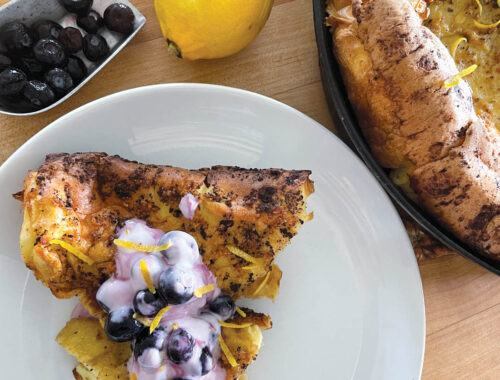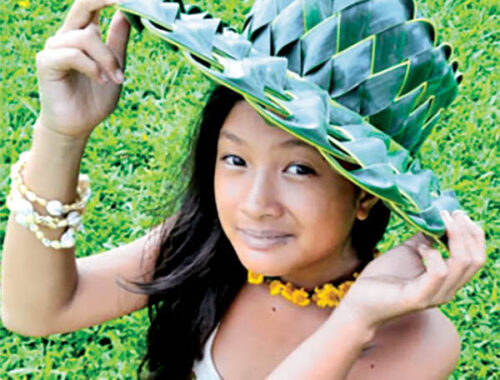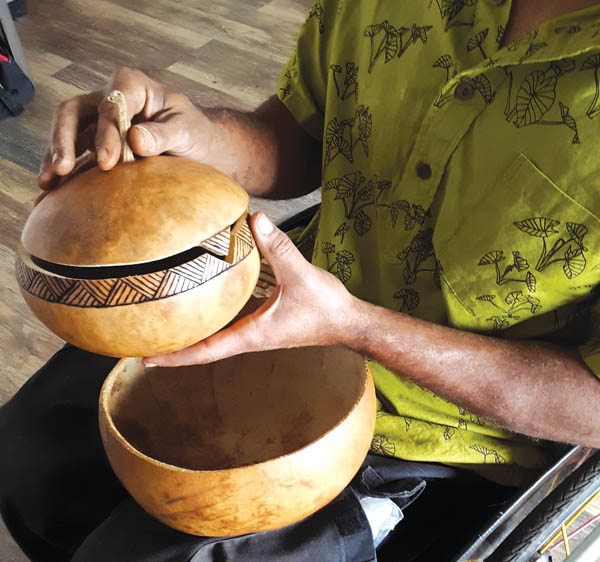
Ipu Stories—From Seed to Stage
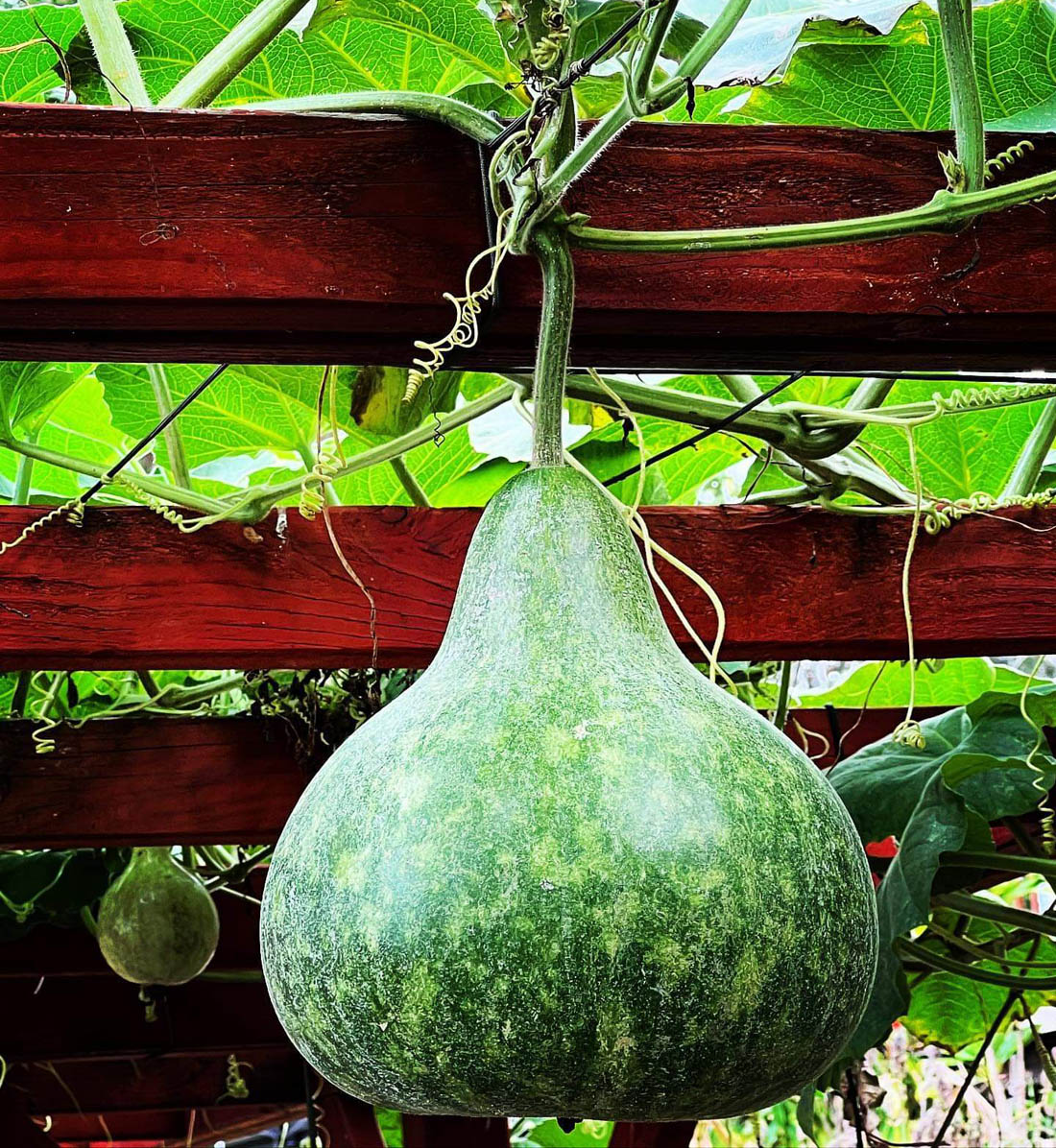
By Nancy S. Kahalewai
There are few things as unique as the feel, shape, sound, texture, decoration, source, and even lineage of a Hawaiian ipu drum. Pahu (drums) are part of the bedrock of traditional Hawaiian hula traditions, dancing, and chanting—thus oral storytelling itself.
Ipu refers to the gourd or fruit of the Cucurbitaceae (squash) family Lagenaria siceraria. Although not edible, this gourd was so valuable to Polynesian culture that it was one of the original voyaging canoe plants of Pacifica, where its bowl shape was very handy at sea for serving food, holding bait and fish, catching rainwater from the sails, or bailing out water from the canoe hulls. The historical uses of this plant’s fruit include diverse purposes such as water vessels, storage containers, rattles, and ceremonies.
For centuries in the Hawaiian Islands, the decorated bowl-shaped ipu ‘umeke was also inverted for use as a ceremonial headdress, while the double ipu heke drums became invaluable as percussion instruments for ‘oli (chanting) or hula kahiko (ancient hula). Also used are the smaller ‘ulī‘ulī gourds for rhythmic accompaniment.
All steps of growing, cultivating, pollinating, harvesting, cleaning, decorating, playing, sharing, and overall appreciation of ipu drums are full of meaning, as well as challenges. For example, the weather may ruin entire crops and the bugs love to bite the fruits, which ruin the development of the gourds.
Establishing Relationships
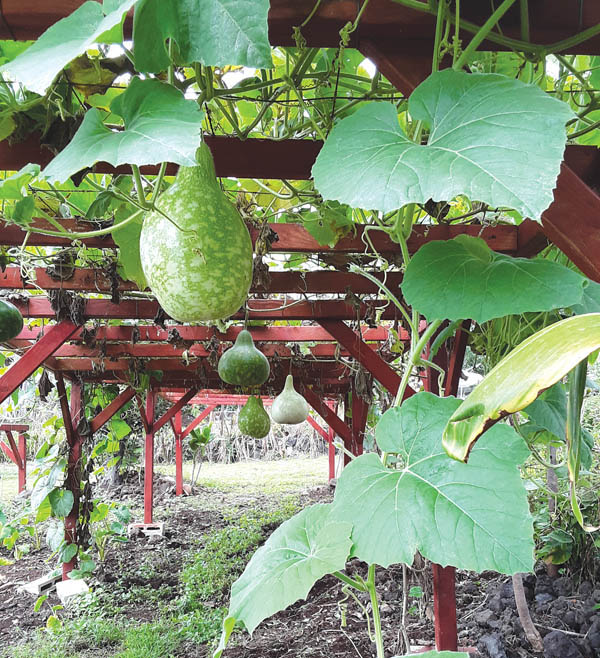
In Kona, Keauhou farmer Kalim Smith calls this whole process “from seed to stage.” For him it is a very personal and intimate journey that includes knowing where and who the seeds came from, how to save and plant seeds, noticing if they grow happily or not, where in the garden they thrive, if they need water or more shade, and basically deeply observing them for at least nine months as they ascend the trellises he builds over them.
Ipu seed stocks are valued and shared based on the desired sizes and shapes, as well as their source. Kalim prefers to plant his seeds directly into the soil. Because Kona is so rocky, this includes adding mulch and a bit of animal fertilizer. “It’s very hard to transplant young plants as their roots are so sensitive and timing has to be just right,” he says. “I also like to hand pollinate my plants.”
Once mature, the gourds are harvested, cleaned, and prepared for their next destination and purpose. Kalim is known for his ipu heke, which for him includes matching the shapes and sounds with the kumu hula who chooses his drums, and personal delivery of the ipu from his hands into theirs.
He also has developed amazing relationships with the Hawaiian black pigs, starting with “Beefcake” who he caught and hand-trained in one day with the calming help of one of his tame ranch pigs. Now half a dozen of these native heritage-breed pigs live on the farm, eating farm scraps and fallen fruit. Other wild Hawaiian pigs roam through occasionally, yet seem to have an unusual relationship with the farm. “They rarely bother my gourds,” notes Kalim. “Unbothered by my presence, sometimes they pass right by me as if they know I respect them.” He compares harmonic relationships on the ‘āina to the legends of Lono’s deeply nurturing relationship with agriculture, the kukui tree, the gourds, and the pigs.

Mo‘olelo (Origin Stories)
Ipu gourds and their seeds have collectively developed their own legends and mo‘olelo over many generations. Kalim’s own gourd-growing journey began in the vicinity of San Diego, California, where he was born and raised. His father is from Tennessee, and was stationed at a San Diego military base.
A retired Navy Chief, Kalim’s father is of Muskogee Creek ancestry and was a leader in the Native American community of Tennessee for many years. He took Kalim to the family farm as a child to see the farming heritage of the mid-South. Lighter than pottery or metal pots, Kalim’s father’s family used gourds to carry water until recent times. Growing up near many reservations in the southwest, Indian elders and the late Dale Phillips, his hānai father and tribal ceremonial leader of the Cocopah Nation, took him to tribal gatherings and taught him how to make ceremonial gourd rattles that were filled with native palm tree seeds.

For five years now, Kalim and his wife, kumu hula Lily Kahelelani Lyons Alohikea-Smith, have been living and growing gourds, animals, and food on the six-acre farm and property of Hālau Ka‘eaikahelelani where they reside in mauka (upland) Keauhou-Kona. The farm was very overgrown with walls of invasive plants when Kahelelani’s hālau acquired the lease, and right away they began clearing and planting. The property also has a tropical fruit orchard of mature trees including starfruit, starapple, lychee, abiu, mountain apple, jackfruit, ice cream bean, white guava, dwarf wi apple, avocado, and mango.
Living here feels very natural and sacred to them. Kahelelani and her sisters have family roots on this Keauhou ahupua‘a (ancient land parcel) that connect them to Queen Keōpūolani and her son, Kauikeaouli, Kamehameha III. “Queen Keōpūolani was my ancestor’s cousin and gave birth to the king just below the farm at Keauhou Bay,” Kahelelani explains. “I am a senior descendant of my great-grandfather, hereditary Ali‘i (High Chief) Alfred Unauna Alohikea who was a composer and state representative for Kaua‘i. It is not only a personal calling to accept and embrace this kuleana [responsibility], but a wonderful and sustainable lifestyle that we truly cherish. I am supposed to be here. I felt my kūpuna [ancestors]; then later I gradually grew to understand it.”
The farm is the location of after-school hula classes on Wednesdays, and Kalim teaches the children about the farm and how to grow food. After class the children pick fruit to enjoy from the orchard, taking some home to their families each week.
Kalim adds, “We are using natural, indigenous methods of living and growing on this ‘āina, and following the traditional ways of the kūpuna who guide and shed light on our ongoing purpose and activities in life.”
As well as sharing seeds and learning how to grow ipu gourds, the ways to tattoo and decorate them is another whole topic, and in this way the mo‘olelo deepens and is perpetuated generation after generation.
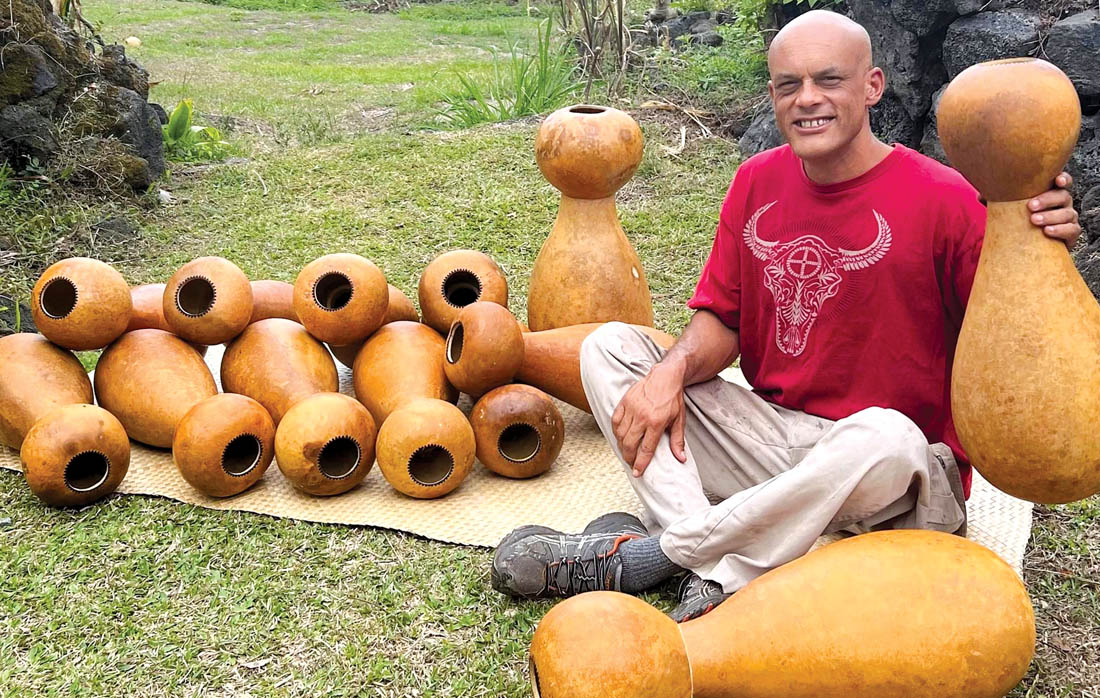
Many Mentors
Kalim’s mentors also included his late grand-aunt and uncle, Aunty Donna Mae (Hopkins) Jensen, remembered as the “Ipu Lady” of Waimea, and her husband Uncle Roy Jensen. “The genealogy of how I was trained is that my grand Aunty Donna and Uncle Roy first asked me to grow large Hawaiian style ipu. After bringing a successful crop back to them, they then taught me to make ipu heke. Years later they gave me the permission to teach, which I have been doing for years now with students from all around the world,” he recalls. “My relative from O‘ahu, entertainer Kama Hopkins, encouraged us to grow ipu as a family. I also have received seeds from other growers and have been fortunate to find many ipu growing in the wild.”
Another mentor of Kalim’s is Aunty Momi Greene, who took on the challenge of farming on six acres of lava. Along with planting 800 commercial plumeria plants for flower lei, she got started growing gourds with her first 40 seeds from now-retired Dr. Bruce Kaimiloa Chrisman. Thanks to his research and dedication, he invited local farmers to help restore ipu growing in Hawai‘i in the 1980s with assistance from Bishop Museum, where 400-year-old ipu drums are housed.
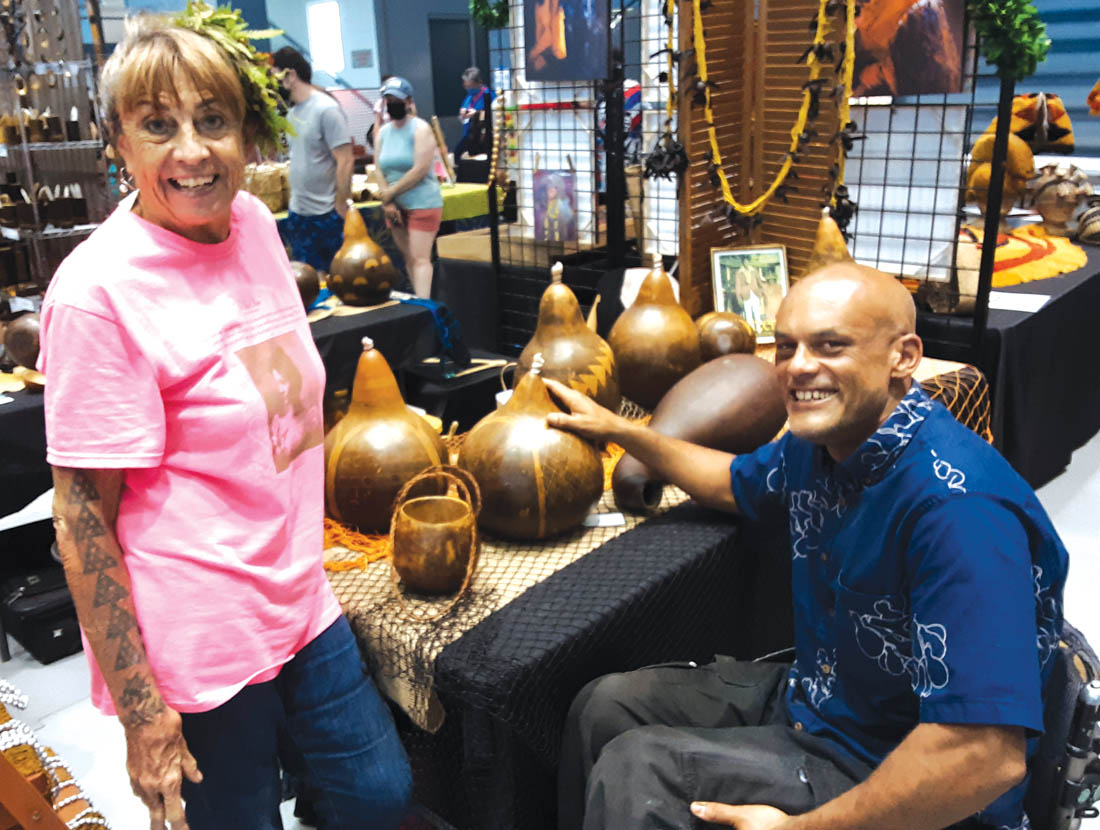
“Ipu don’t like to grow in containers,” Momi learned as one of these early farmers, “as their roots hate to be bound. Once they start to flower, I pollinate by hand. The female and male flowers grow right next door to each other on the vine. It’s an amazing plant.” An artist of Hawaiian, German, and Maori descent, Momi also learned how to decorate ipu in the lost Ni‘ihau method. Dying the gourd is done from the inside out—an almost forgotten ipu pawehe (tattoo method) endemic to the Hawaiian Islands.
The gourd is picked while still green, yet after the leaves and vines have dried out. Momi cuts a small opening and removes the stem and seeds. Artistic patterns and traditional designs are created by peeling (like an apple) and carving the young, green skins before they are dry and brown. Then dark dyes such as coffee or brews from tree barks are added inside the gourd where they remain for about a month. Through osmosis, the dyes permeate from the inside to the outer skin wherever the skin has been removed. Thus, the contrasting patterns emerge as the carved areas darken.
The fermented pulp and liquid are then cleaned out. Traditionally, the gourds are taken to the beach where the crusty exterior is hand cleaned with seawater and scrubbed with damp sand. Filling them with seawater for one week to help minimize bugs and mold precedes drying them out thoroughly for several weeks.
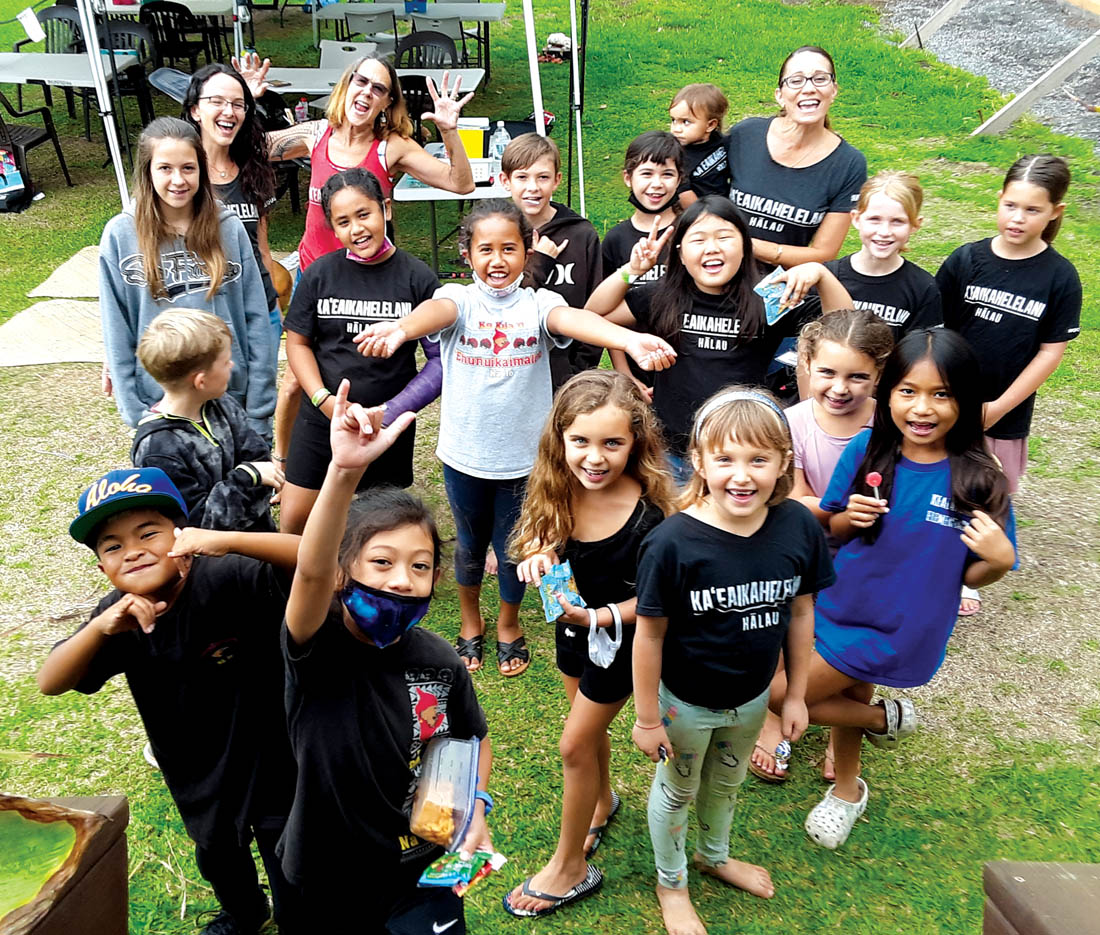
Deep Dedication
The journey from planting to finishing gourds takes a good year of care and dedication that is “like raising a child,” as one kupuna remarked. Ipu farmers, artisans, dancers and musicians share a deep appreciation for this humble plant. From seed to stage and beyond, this is an inspirational part of a culture where their own roots thrive and where they can cherish the intimate traditions of pre-contact Hawai‘i. ❖
For more information:
facebook.com/ipufarm, facebook.com/momi.greene

